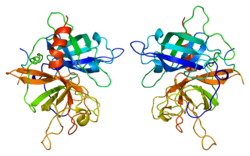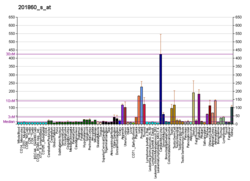Ischemic stroke
Statistics
There have been 12 large scale, high-quality trials of rtPA in acute ischemic stroke. A meta-analysis of these trials concluded that rtPA given within 6 hours of a stroke significantly increased the odds of being alive and independent at final follow-up, particularly in patients treated within 3 hours. However a significant mortality rate was noted, mostly from intracranial haemorrhage at 7 days, but later mortality was not significant amongst treated and non-treated patients. [7]
It has been suggested that if tPA is effective in ischemic stroke, it must be administered as early as possible after the onset of stroke symptoms, given that patients present to an ED in a timely manner. [7] [8] Many national guidelines including the AHA have interpreted this cohort of studies as suggesting that there are specific subgroups who may benefit from tPA and thus recommend its use within a limited time window after the event. Protocol guidelines require its use intravenously within the first three hours of the event, after which its detriments may outweigh its benefits.
For example, the Canadian Stroke Network guideline states "All patients with disabling acute ischemic stroke who can be treated within 4.5 hours of symptom onset should be evaluated without delay to determine their eligibility for treatment" with tPA. [9] Delayed presentation to the ED leads to decreased eligibility; as few as 3% of people qualify for this treatment. [10] Similarly in the United States, the window of administration used to be 3 hours from onset of symptoms, but the newer guidelines also recommend use up to 4.5 hours after symptom onset, depending on the patient's presentation, past medical history, current comorbidities and medication usage. [11] tPA appears to show benefit not only for large artery occlusions but also for lacunar strokes. Since tPA dissolves blood clots, there is risk of hemorrhage with its use. [12] [13]
Administration criteria
Use of tPA in the United States in treatment of patients who are eligible for its use, have no contraindications, and arrival at the treating facility less than 3 hours after onset of symptoms, is reported to have doubled from 2003 to 2011. Use on patients with mild deficits, of nonwhite race/ethnicity, and oldest old age increased. However, many patients who were eligible for treatment were not treated. [14] [15]
tPA has also been given to patients with acute ischemic stroke above age 90 years old. Although a small fraction of patients 90 years and above treated with tPA for acute ischemic stroke recover, most patients have a poor 30-day functional outcome or die. [16] Nonagenarians may do as well as octogenarians following treatment with IV-tPA for acute ischemic stroke. [17] In addition, people with frostbite treated with tPA had fewer amputations than those not treated with tPA. [18]
General consensus on use
There is consensus amongst stroke specialists that tPA is the standard of care for eligible stroke patients, and benefits outweigh the risks. There is significant debate mainly in the emergency medicine community regarding recombinant tPA's effectiveness in ischemic stroke. The NNT Group on evidence-based medicine concluded that it was inappropriate to combine these twelve trials into a single analysis, because of substantial clinical heterogeneity (i.e., variations in study design, setting, and population characteristics). [19] Examining each study individually, the NNT group noted that two of these studies showed benefit to patients given tPA (and that, using analytical methods that they think flawed); four studies showed harm and had to be stopped before completion; and the remaining studies showed neither benefit nor harm. On the basis of this evidence, the NNT Group recommended against the use of tPA in acute ischaemic stroke. [19] The NNT Group notes that the case for the 3-hour time window arises largely from analysis of two trials: NINDS-2 and subgroup results from IST-3. "However, presuming that early (0-3h) administration is better than later administration (3-4.5h or 4.5-6h) the subgroup results of IST-3 suggest an implausible biological effect in which early administration is beneficial, 3-4.5h administration is harmful, and 4.5-6h administration is again beneficial." [19] Indeed, even the original publication of the IST-3 trial found that time-window effects were not significant predictors of outcome (p=0.61). [20] In the UK, concerns by stroke specialists have led to a review by the Medicines and Healthcare products Regulatory Agency. [21]


















